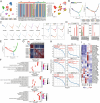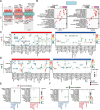Single-cell profiling of response to neoadjuvant chemo-immunotherapy in surgically resectable esophageal squamous cell carcinoma
- PMID: 38566201
- PMCID: PMC10985969
- DOI: 10.1186/s13073-024-01320-9
Single-cell profiling of response to neoadjuvant chemo-immunotherapy in surgically resectable esophageal squamous cell carcinoma
Abstract
Background: The efficacy of neoadjuvant chemo-immunotherapy (NAT) in esophageal squamous cell carcinoma (ESCC) is challenged by the intricate interplay within the tumor microenvironment (TME). Unveiling the immune landscape of ESCC in the context of NAT could shed light on heterogeneity and optimize therapeutic strategies for patients.
Methods: We analyzed single cells from 22 baseline and 24 post-NAT treatment samples of stage II/III ESCC patients to explore the association between the immune landscape and pathological response to neoadjuvant anti-PD-1 combination therapy, including pathological complete response (pCR), major pathological response (MPR), and incomplete pathological response (IPR).
Results: Single-cell profiling identified 14 major cell subsets of cancer, immune, and stromal cells. Trajectory analysis unveiled an interesting link between cancer cell differentiation and pathological response to NAT. ESCC tumors enriched with less differentiated cancer cells exhibited a potentially favorable pathological response to NAT, while tumors enriched with clusters of more differentiated cancer cells may resist treatment. Deconvolution of transcriptomes in pre-treatment tumors identified gene signatures in response to NAT contributed by specific immune cell populations. Upregulated genes associated with better pathological responses in CD8 + effector T cells primarily involved interferon-gamma (IFNγ) signaling, neutrophil degranulation, and negative regulation of the T cell apoptotic process, whereas downregulated genes were dominated by those in the immune response-activating cell surface receptor signaling pathway. Natural killer cells in pre-treatment tumors from pCR patients showed a similar upregulation of gene expression in response to IFNγ but a downregulation of genes in the neutrophil-mediated immunity pathways. A decreased cellular contexture of regulatory T cells in ESCC TME indicated a potentially favorable pathological response to NAT. Cell-cell communication analysis revealed extensive interactions between CCL5 and its receptor CCR5 in various immune cells of baseline pCR tumors. Immune checkpoint interaction pairs, including CTLA4-CD86, TIGIT-PVR, LGALS9-HAVCR2, and TNFSF4-TNFRSF4, might serve as additional therapeutic targets for ICI therapy in ESCC.
Conclusions: This pioneering study unveiled an intriguing association between cancer cell differentiation and pathological response in esophageal cancer patients, revealing distinct subgroups of tumors for which neoadjuvant chemo-immunotherapy might be effective. We also delineated the immune landscape of ESCC tumors in the context of clinical response to NAT, which provides clinical insights for better understanding how patients respond to the treatment and further identifying novel therapeutic targets for ESCC patients in the future.
Keywords: Esophageal squamous cell carcinoma; Neoadjuvant therapy; Pathological response; Single-cell sequencing.
© 2024. The Author(s).
Conflict of interest statement
SW and QXO are employees of Nanjing Geneseeq Technology Inc. The other authors declare that they have no competing interests.
Figures





References
-
- Yang H, Liu H, Chen Y, Zhu C, Fang W, Yu Z, et al. Neoadjuvant Chemoradiotherapy Followed by Surgery Versus Surgery Alone for Locally Advanced Squamous Cell Carcinoma of the Esophagus (NEOCRTEC5010): A Phase III Multicenter, Randomized. Open-Label Clinical Trial J Clin Oncol. 2018;36(27):2796–2803. - PMC - PubMed
Publication types
MeSH terms
Substances
Grants and funding
LinkOut - more resources
Full Text Sources
Medical
Research Materials

